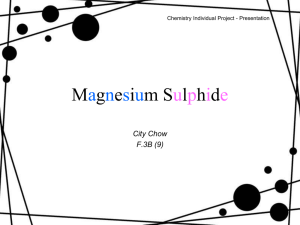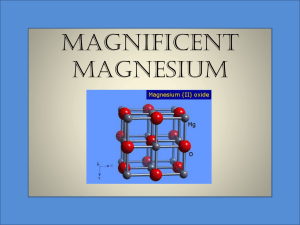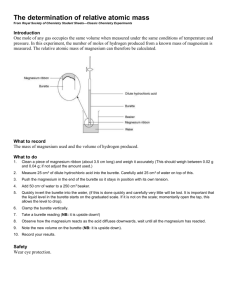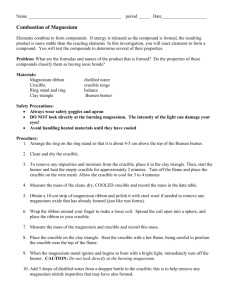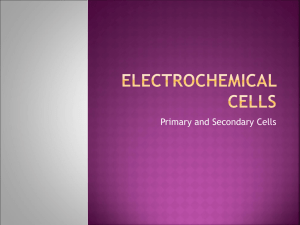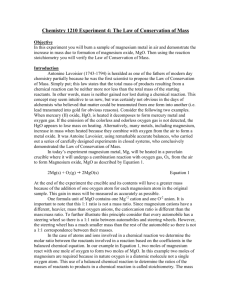Burning Magnesium Lab
advertisement
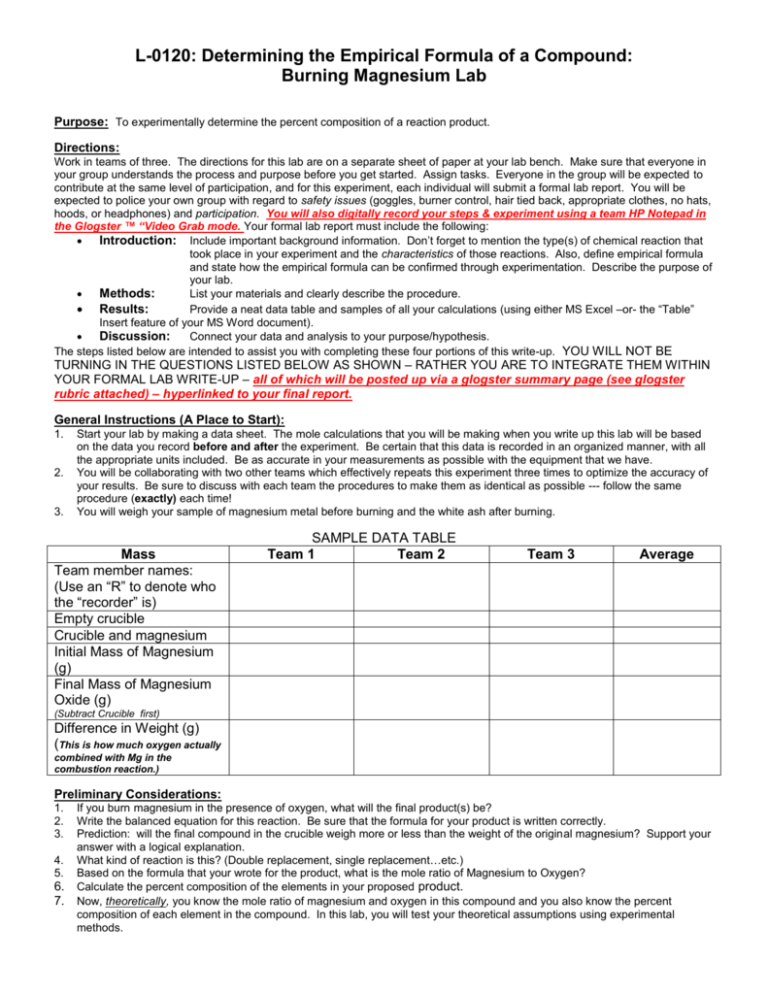
L-0120: Determining the Empirical Formula of a Compound: Burning Magnesium Lab Purpose: To experimentally determine the percent composition of a reaction product. Directions: Work in teams of three. The directions for this lab are on a separate sheet of paper at your lab bench. Make sure that everyone in your group understands the process and purpose before you get started. Assign tasks. Everyone in the group will be expected to contribute at the same level of participation, and for this experiment, each individual will submit a formal lab report. You will be expected to police your own group with regard to safety issues (goggles, burner control, hair tied back, appropriate clothes, no hats, hoods, or headphones) and participation. You will also digitally record your steps & experiment using a team HP Notepad in the Glogster ™ “Video Grab mode. Your formal lab report must include the following: Introduction: Include important background information. Don’t forget to mention the type(s) of chemical reaction that took place in your experiment and the characteristics of those reactions. Also, define empirical formula and state how the empirical formula can be confirmed through experimentation. Describe the purpose of your lab. Methods: List your materials and clearly describe the procedure. Results: Provide a neat data table and samples of all your calculations (using either MS Excel –or- the “Table” Insert feature of your MS Word document). Discussion: Connect your data and analysis to your purpose/hypothesis. The steps listed below are intended to assist you with completing these four portions of this write-up. YOU WILL NOT BE TURNING IN THE QUESTIONS LISTED BELOW AS SHOWN – RATHER YOU ARE TO INTEGRATE THEM WITHIN YOUR FORMAL LAB WRITE-UP – all of which will be posted up via a glogster summary page (see glogster rubric attached) – hyperlinked to your final report. General Instructions (A Place to Start): 1. 2. 3. Start your lab by making a data sheet. The mole calculations that you will be making when you write up this lab will be based on the data you record before and after the experiment. Be certain that this data is recorded in an organized manner, with all the appropriate units included. Be as accurate in your measurements as possible with the equipment that we have. You will be collaborating with two other teams which effectively repeats this experiment three times to optimize the accuracy of your results. Be sure to discuss with each team the procedures to make them as identical as possible --- follow the same procedure (exactly) each time! You will weigh your sample of magnesium metal before burning and the white ash after burning. Mass Team member names: (Use an “R” to denote who the “recorder” is) Empty crucible Crucible and magnesium Initial Mass of Magnesium (g) Final Mass of Magnesium Oxide (g) SAMPLE DATA TABLE Team 1 Team 2 Team 3 Average (Subtract Crucible first) Difference in Weight (g) (This is how much oxygen actually combined with Mg in the combustion reaction.) Preliminary Considerations: 1. 2. 3. 4. 5. 6. 7. If you burn magnesium in the presence of oxygen, what will the final product(s) be? Write the balanced equation for this reaction. Be sure that the formula for your product is written correctly. Prediction: will the final compound in the crucible weigh more or less than the weight of the original magnesium? Support your answer with a logical explanation. What kind of reaction is this? (Double replacement, single replacement…etc.) Based on the formula that your wrote for the product, what is the mole ratio of Magnesium to Oxygen? Calculate the percent composition of the elements in your proposed product. Now, theoretically, you know the mole ratio of magnesium and oxygen in this compound and you also know the percent composition of each element in the compound. In this lab, you will test your theoretical assumptions using experimental methods. Procedure: 1. Under the supervision of your teacher: cut off approximately 42 cm of the magnesium metal strip provided by your teacher. 2. Obtain the mass of a 5 cm x 5 cm aluminum boat using an electronic balance. Record its mass. 3. Tear up the Mg strip into smaller pieces (that will fit into your crucible and not overhang the edge) and place them on the aluminum boat and weigh them both. Carefully find the mass of the boat and Mg strip together. 4. Subtract the weight of the empty boat to find the mass of the magnesium. Record this mass in your data table. (Warning: keep track of your aluminum boats at all times. If you accidentally pick up a different boat, your initial data will be inaccurate.) 5. Using the painter’s brush, brush the magnesium strips into the crucible resting inside a clay triangle mounted on the ring stand. Using the propane torch provided carefully heat the magnesium by passing the flame back and forth for approximately two minutes, then bring the flame to bear upon the magnesium to increase the heat. After a few more seconds, the magnesium will ignite. Remove the torch and turn it off. Caution: the crucible will be very hot, so keep your glasses on at all times and stand at a distance from the flame. Hairline fractures in the crucible might cause the vessel to shatter at high temperatures! Be alert! Also: the magnesium metal will FLARE UP! Do not look directly at the flame and keep clear of the burning metal as it combusts! 6. You can use the tongs to “check on” the progress of your experiment. Make sure all of the magnesium has been converted to the white oxide ash. Repeat step 5 should some portions of magnesium metal remain. When is the metal fully combusted it will have the look of white powder. Turn off the flame and let the crucible cool completely before moving it to the balance. 7. Brush the white oxide ash onto your pre-weighed aluminum boat. Obtain the mass of the boat and combustion product. Record the final mass in your data table. Subtract the weight of the boat from the combined mass in order to determine the mass of the white oxide product. 8. Share your team’s data with the other two teams’ recorder while obtaining their results for your team. This should provide a total of three trials. 9. Answer the questions in the section below for each team’s sample AND then for the “Average” as well. Materials: One strip of metal magnesium ribbon (approximately 3.0 grams –or- about 42.0 cm in length); One digital electronic balance capable of reading out to three decimal places (0.001 grams); Tongs 01 Crucible 01 Ring stand w/ring 01 Propane torch w/electronic ignition switch 01 Safety goggles 01 Lab apron 01 Digital camera HP Notepad No.2 pencil 02 Notebook paper with appropriate table for recording initial data Flash or thumb drive (1 gig minimum) 01 5 cm x 5 cm “aluminum boat” 01 Painter’s brush (less than 1 inch diameter) 01 Clay triangle 01 Determining the Empirical Formula of Magnesium Oxide: 1. After you complete the experiment, determine the number of moles of Magnesium involved in the reaction. Use the “Average” Initial Mass for this calculation. 2. Likewise, you need to determine the number of moles of Oxygen involved in the reaction. This is trickier, because you didn’t actually weigh the oxygen beforehand. Therefore, we assume that any weight that was “gained” by the magnesium is actually just the Oxygen from the air that combined with it. Therefore, to calculate the amount of oxygen you used in this experiment, subtract the Final Mass of the product from the Initial Mass of the Magnesium. This weight, in grams, can be converted to moles of oxygen, using the “grams to moles” strategy. 3. Now you know the mole to mole ratio of the two elements in the compound. Do your results support your theoretical assumptions about the formula for Magnesium Oxide? 4. Go back and compare the Percent Composition figures that you calculated earlier to see if the mass of your “experimental” reactants and products reflects the “theoretical” values that you predicted. In other words, what is the percent composition of your experimental product?


